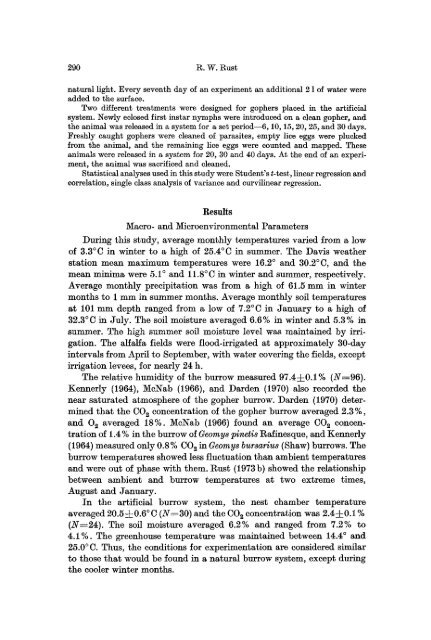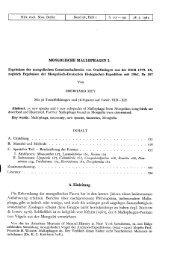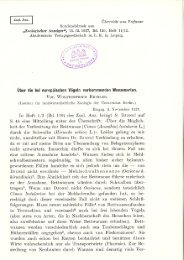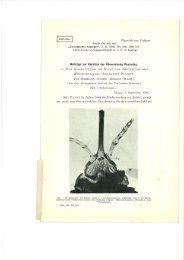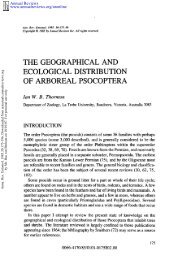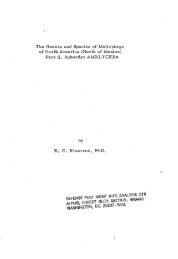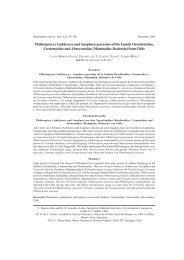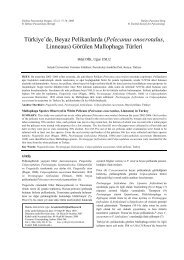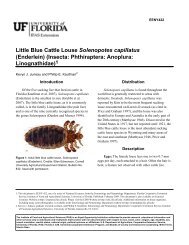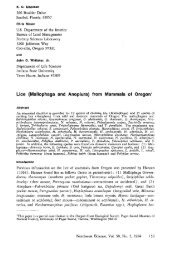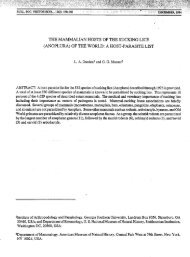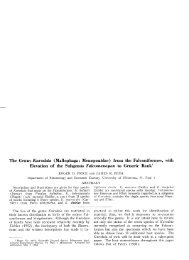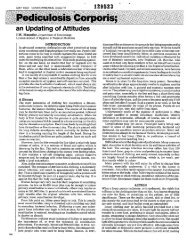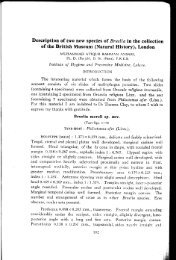The population dynamics and host utilization of ... - Phthiraptera
The population dynamics and host utilization of ... - Phthiraptera
The population dynamics and host utilization of ... - Phthiraptera
Create successful ePaper yourself
Turn your PDF publications into a flip-book with our unique Google optimized e-Paper software.
290 R.W. Rus~<br />
natural light. Every seventh day <strong>of</strong> an experiment an additional 21 <strong>of</strong> water were<br />
added to the surface.<br />
Two different treatments were designed for gophers placed in the artificial<br />
system. Newly eclosed first instar nymphs were introduced on a clean gopher, <strong>and</strong><br />
the animal was released in a system for a set period--6, 10, 15, 20, 25, <strong>and</strong> 30 days.<br />
Freshly caught gophers were cleaned <strong>of</strong> parasites, empty lice eggs were plucked<br />
from the animal, <strong>and</strong> the remaining lice eggs were counted <strong>and</strong> mapped. <strong>The</strong>se<br />
animals were released in a system for 20, 30 <strong>and</strong> 40 days. At the end <strong>of</strong> an experiment,<br />
the animal was sacrificed <strong>and</strong> cleaned.<br />
Statistical analyses used in this study were Student's t-test, linear regression <strong>and</strong><br />
correlation, single class analysis <strong>of</strong> variance <strong>and</strong> curvilinear regression.<br />
Results<br />
Macro- <strong>and</strong> Microenvironmental Parameters<br />
During this study, average monthly temperatures varied from a low<br />
<strong>of</strong> 3.3~ in winter to a high <strong>of</strong> 25.4~ in summer. <strong>The</strong> Davis weather<br />
station mean maximum temperatures were 16.2 ~ <strong>and</strong> 30.2~ <strong>and</strong> the<br />
mean minima were 5.1 ~ <strong>and</strong> 11.8~ in winter <strong>and</strong> summer, respectively.<br />
Average monthly precipitation was from a high <strong>of</strong> 61.5 mm in winter<br />
months to 1 mm in summer months. Average monthly soil temperatures<br />
at 101 mm depth ranged from a low <strong>of</strong> 7.2~ in January to a high <strong>of</strong><br />
32.3~ in July. <strong>The</strong> soil moisture averaged 6.6% in winter <strong>and</strong> 5.3% in<br />
summer. <strong>The</strong> high summer soil moisture level was maintained by irrigation.<br />
<strong>The</strong> alfalfa fields were flood-irrigated at approximately 30-day<br />
intervals from April to September, with water covering the fields, except<br />
irrigation levees, for nearly 24 h.<br />
<strong>The</strong> relative humidity <strong>of</strong> the burrow measured 97.4• (N-=96).<br />
Kennerly (1964), McSTab (1966), <strong>and</strong> Darden (1970) also recorded the<br />
near saturated atmosphere <strong>of</strong> the gopher burrow. Darden (1970) determined<br />
that the CO S concentration <strong>of</strong> the gopher burrow averaged 2.3 %,<br />
<strong>and</strong> 03 averaged 18%. MeNab (1966) found an average CO S concentration<br />
<strong>of</strong> 1.4 % in the burrow <strong>of</strong> Geomys pinetis Rafinesque, <strong>and</strong> Kennerly<br />
(1964) measured only 0.8 % CO S in Geomys bursarius (Shaw) burrows. <strong>The</strong><br />
burrow temperatures showed less fluctuation than ambient temperatures<br />
<strong>and</strong> were out <strong>of</strong> phase with them. Rust (1973b) showed the relationship<br />
between ambient <strong>and</strong> burrow temperatures at two extreme times,<br />
August <strong>and</strong> January.<br />
In the artificial burrow system, the nest chamber temperature<br />
averaged 20.5-V0.6~ C (N-=30) <strong>and</strong> the CO S concentration was 2.4-4-0.1%<br />
(N=24). <strong>The</strong> soil moisture averaged 6.2% <strong>and</strong> ranged from 7.2% to<br />
4.1%. <strong>The</strong> greenhouse temperature was maintained between 14.4 ~ <strong>and</strong><br />
25.0 ~ C. Thus, the conditions for experimentation are considered similar<br />
to those that would be found in a natural burrow system, except during<br />
the cooler winter months.


